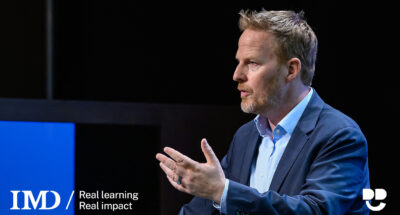
When it comes to trust, your actions speak louder than words
People don’t work for companies. They work for leaders they trust. And that trust is being tested like never before....
Audio available

by Maude Pittet Nazareno, Francesca Giulia Mereu Published 2 August 2024 in Leadership • 6 min read
Whether the aim is to establish a humanitarian aid corridor or to ensure access to vulnerable people, negotiation is a crucial part of the work of frontline humanitarian staff. Yet the outcome of any negotiation is often undermined by a lack of trust between the two sides, with counterparts deeply suspicious of the intentions of humanitarian organizations.
Depending on their aim, humanitarian negotiators rely on three types of negotiations:
The added challenge is that even for transactional or adversarial negotiations to succeed, you must establish a baseline of trust and a relationship with your negotiating party.
For those working in a business environment, you will likely negotiate with peers, team members, and other stakeholders throughout your working day. Although you hopefully won’t be facing the same conditions as those operating in war zones, some negotiations can be more fraught than others. Research has found that internal team dynamics is a frequent source of pressure, requiring similar negotiation skills as those used in the field or on the frontline.
Imagine, for example, that you need to find time for a difficult conversation with a stakeholder whose behavior risks undermining the success of a project and causing significant reputational damage to your team or organization. What lessons from frontline humanitarian negotiation practices could be applied to your situation?

First, let’s examine what happens to your brain when you enter a negotiation. According to neuroscience, there are three parts of the brain involved in risk assessment, decision-making, behavior, and influence:
In negotiations, your non-verbal communication (facial expressions, posture, behavior, emotional expressions, tone, and pace of voice) is primarily controlled by your physical and emotional brain, while verbal communication (word choice, listening and understanding skills, empathy) mostly happens between the emotional and cognitive brains.
When you act in protective mode – like your inner dog – it can limit your ability to be creative, inspire others, innovate, welcome new ideas, adapt, and find solutions. Instead, you become protective of what you value, recognize, and know – your point of view and territory.
When you act defensively (our inner crocodile), you lose even more emotional brain skills, such as empathy and kindness.
While the tension and danger that come from working on the frontline can push people to operate in these protective and defensive zones, even in normal daily life, micro stressors such as a traffic jam, miscommunication with your partner or colleague, sleep deprivation, a lack of resources or a crisis can trigger our inner dog or crocodile.
Combining insights from those experienced in humanitarian negotiations with our understanding of brain science, it’s evident that to move from a confrontational stance to a more cooperative way of interacting, we should follow a three-step process. Importantly, these steps must be taken in a certain order.

Even if your time is limited, there are techniques you can apply before you start negotiating to tame your inner crocodile and dog and pique your monkey’s curiosity.
Start by exhaling deeply for a few seconds to relax your mind. Reflect on any commonalities you share with your counterpart, as this fosters a subconscious sense of camaraderie, making you feel united.
Finally, approach the negotiation with an open mind, contemplating the reasons behind your counterpart’s actions and maintaining a positive view of their behavior. This will spark your curiosity and help you transition from a defensive stance to a more receptive and collaborative one.
When you are ready to negotiate, there are techniques you can apply to tame your counterpart’s zoo.
Start by addressing their physical needs to create a sense of safety. Even simple actions like offering someone a glass of water or adjusting the air conditioning to their liking can help de-escalate tension and provide some breathing room before the negotiation starts.
Find similarities and common ground to establish rapport. Use mirroring techniques, such as matching tone and pace of voice, to create a connection. This can be effective online as well. Show genuine interest in the other’s concerns to soften their protective stance.
Engage the neocortex with open-ended questions that stimulate curiosity and shift the focus to solutions. Questions like “What’s on your mind?” or “What do you think are some possible ways forward?” can facilitate a co-creative dialogue.
When time is short, acknowledge the need for efficiency but start with a brief moment of connection.
When time is short, acknowledge the need for efficiency but start with a brief moment of connection. For example, “I know we only have 10 minutes, but let’s take a minute to settle in and check how you’re doing before diving into the main topic.”
Every conversation, interaction, or negotiation is like a tango: to lead, you must also follow. By continuously observing all the “animals” present – yours and your counterpart’s – you can detect behavioral changes, identify the level at which they occur, and address them appropriately before they escalate.
Whether under pressure on the front line or during a difficult conversation with a team member, these negotiation principles can be applied to help leaders navigate the “wild” landscape of team dynamics and negotiation.

Project Manager : Mentoring and Pressure Management in Frontline
For 20 years, Pittet Nazareno has been engaged with international humanitarian organizations as a certified coach, project manager, and facilitator in pressure management and resilience programs. She works with the Center of Competence on Humanitarian Negotiation (CCHN), which supports humanitarian negotiators active in the frontline of armed conflicts and complex crises.

Executive coach
An executive coach with over 25 years of experience, she is also the author of Recharge Your Batteries and a certified yoga teacher. Her “Energy Check” is available online. She regularly works with the Center of Competence on Humanitarian Negotiation (CCHN) and at IMD with senior leaders of global organizations. Follow her LinkedIn Group on managing your energy.

29 May 2025 • by Shelley Zalis in Leadership
People don’t work for companies. They work for leaders they trust. And that trust is being tested like never before....
 Audio available
Audio available
26 May 2025 in Leadership
In an I by IMD interview, Ros Taylor, author of The Future of Trust, explores how the nebulous nature of globalization has fractured trust in institutions and triggered a renewal of faith...
 Audio available
Audio available
19 May 2025 • by David Bach, Felix Zeltner in Leadership
Global deans Catherine Duggan and Darren Dahl on leading through turbulence — and why optimism, not certainty, is the real power in today’s business education. ...

19 May 2025 • by Peter Voser in Leadership
Board members have a central role to play in helping organizations steer a safe path in a polarized and skeptical world....
 Audio available
Audio availableExplore first person business intelligence from top minds curated for a global executive audience